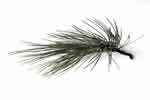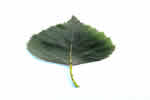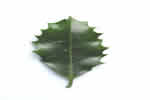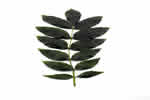Trees The history of Irish trees begins at the end of the last ice age which was 13,000 years ago. Gradually the plants, trees and animals returned. The first trees were those which could tolerate cold and damp and whose seeds were spread by the wind, such as willow, alder and birch. However, these were eventually replaced by an oak forest which along with other trees covered 90% of the Irish landscape. It is hard to imagine that such a huge forest is what the first people who came to Ireland would have seen 8,000 years ago. Today only 6% of Ireland is forested with mostly introduced coniferous forest. The original deciduous forest now only covers 1% of the landscape.
Oak Quercus robur (Fagaceae) Oaks are deciduous broadleaved trees which can support more species of wildlife that any other Irish tree. The leaves are widest above the middle with 5-7 lobes, dark green above and blue-green beneath. Flowers are borne in catkins: the male is yellow-green and drooping females inconspicuous which in turn produce acorns ripening to a dark brown colour.
- Habitat: Woodland, mountain, park land
- Height: 35m Spread: 30m
- Bark: Grey with vertical fissures
- Status: Frequent
- Similar species: Sessile oak, Turkey oak

Rowan Sorbus aucuparia (Rosaceae) This deciduous tree is conical in shape, spreading with age, has shoots that end in purple buds covered in grey hairs. Pinnate leaves have up to 15 sharp toothed, pointed dark green leaves which are blue-green underneath. The small white flowers have five petals and develop into red berries which are poisonous if eaten raw.
- Habitat: Woods, heath-land and hedgerows
- Height: 15m Spread: 10m
- Bark: Grey and smooth, becoming ridged with age
- Status: Frequent
- Similar species: None

Hawthorn Crataegus monogyna (Rosaceae) The smooth thorny stems of this deciduous tree become cracked with age as the tree spreads. The leaves are oval to diamond-shaped in outline with a broad tapered base and 3-5 sharp toothed lobes, glossy and dark green above with a paler underside. The fragrant white flowers are produced in dense clusters followed by a bright red fruit called a haw containing a single stone.
- Habitat: Woods, scrub and hedgerows
- Height: 10m Spread: 10m
- Bark: Orange-brown, cracked and scaling on older trees
- Status: Abundant
- Similar species: Non

Scots Pine Pinus sylvestris (Pinaceae) This impressive evergreen tree is conical when young, developing into a rounded spreading head on a tall trunk when mature. The needles are blue-green to blue-grey, male flowers are cylindrical clusters and yellow in colour. The female are upright, red in colour scattered in ones or twos at the tips of young shoots. They take until the second autumn to mature into egg-shaped woody cones which brown when ripe.
- Habitat: Woodland and mountains, commonly planted and naturalised
- Height: 30m or more Spread: 15m
- Bark: Purple-grey, orange to pink near top of trunk; deeply cracked, flaking into small plates with age
- Status: Occasional
- Similar species: Black pine, Corsican pine, Austrian Pine

Silver Birch Betula pendula (Betulaceae) Silver birch is a medium-sized deciduous tree with a slender trunk and a crown of arched branches with drooping branchlets. The young shoots are rough to the touch with numerous small warts. The glossy and dark leaves are oval to triangular, edged with double teeth, turning yellow in the autumn. The male catkins are drooping while the female are upright. Brown fruit clusters break up when ripe.
- Habitat: Woods, heaths and mountains
- Height: 30m Spread: 20m
- Bark: White with black makings often taking a diamond shape
- Status: Frequent
- Similar species: Downy birch

Common Holly Ilex aquifolium (Aquifoliaceae) Holly is an evergreen tree often shrub-like in form with glossy, dark green leaves. Leaves range from oval to oblong; the spiny leaves are generally concentrated to the lower younger branches while smooth leaves are on older trees with higher shoots. Flowers grow in clusters with male and female on different trees, the bright red berries only occur on the female trees.
- Habitat: Woods and hedgerows, commonly planted
- Height: 20m Spread: 15m
- Bark: Pale grey and smooth
- Status: Abundant
- Similar species: none

Elder Sambucus nigra (Caprifoliaceae) The deciduous elder is often shrubby with several stems coming from the base with twisted growth and arching branches. The leaves sprout on opposite sides, pinnate with 5-7 oval and pointed leaves. The flat heads of white flowers are in clusters 25cm wide and are followed by edible berries which turn black when ripe.
- Habitat: Woods, scrub, hedgerows, and waste land
- Height: 10m Spread: 8m
- Bark: Grey-brown, furrowed and cork-like
- Status: Frequent
- Similar species: Danewort

Common Ash Fraxinus excelsior (Oleaceae) This large deciduous tree has a stout smooth trunk, branches tipped with prominent black buds. The opposite, pinnate leaves have up to 13 dark green leaflets with a slender tapered point at the tip. Tiny purple flowers form in dense clusters, have no petals and form winged fruit which also form in large clusters.
- Habitat: Moist woods and riverbanks, often in hedgerows
- Height: 30m and more Spread: 20m
- Bark: Smooth and pale grey, develops deep fissures with age
- Status: Abundant
- Similar species: None - only native ash

Alder Alnus glutinosa (Betulaceae)
Alder is a deciduous tree, conical in shape with dark green leaves which are paler underneath. The flowers are separate male and female catkins formed during the summer. The males are hanging and yellow, up to 10cm long; the upright females are red and much smaller, about 5mm long.
- Habitat: Riverbanks and wetland areas
- Height: 25m Spread: 12m
- Bark: Dark grey, cracks into square plates on old trees
- Status: Frequent
- Similar species: None due the distinctive leaves, broadest at the end with a notched tip

Yew Taxus baccata (Txaceae) Generally a conical evergreen the yew is often multi-stemmed, with dark green needle-like leaves with two pale bands on the underside spread in two rows either side of the shoots. Male flowers grow beneath the shoots and the female flowers are small green found singly at the end of shoots on separate plants. The fruit has a single seed within a red berry ripening in autumn.
- Habitat: Woods and thickets, commonly planted often as hedges
- Height: 20m Spread: 10m
- Bark: Purple-brown, smooth and flaking
- Status: Occasional
- Similar species: None not easily confused with other species.







